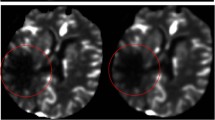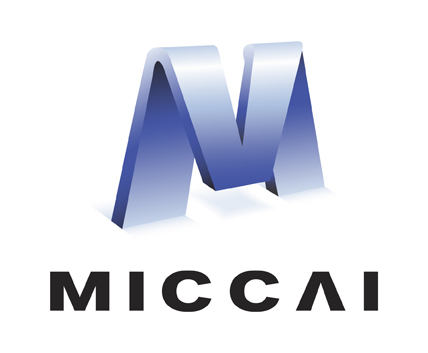Abstract
Perfusion CT is widely used in acute ischemic stroke to determine eligibility for acute treatment, by defining an ischemic core and penumbra. In this work, we propose a novel way of building on prior information for the automatic prediction and segmentation of stroke lesions. To this end, we reformulate the task to identify differences from a prior segmentation by extending a three-dimensional Attention Gated Unet with a skip connection allowing only an unchanged prior to bypass most of the network. We show that this technique improves results obtained by a baseline Attention Gated Unet on both the Geneva Stroke Dataset and the ISLES 2018 dataset.
Access this chapter
Tax calculation will be finalised at checkout
Purchases are for personal use only
Similar content being viewed by others
References
ISLES: Ischemic Stroke Lesion Segmentation Challenge (2018). http://www.isles-challenge.org/
Albers, G.W., et al.: Thrombectomy for Stroke at 6 to 16 Hours with Selection by Perfusion Imaging. New England J. Med. 378(8), 708–718 (2018). https://doi.org/10.1056/NEJMoa1713973. Massachusetts Medical Society, publisher eprint
Shalini, A., et al.: Cerebral blood flow predicts the infarct core. Stroke 50(10), 2783–2789 (2019). https://doi.org/10.1161/STROKEAHA.119.026640. https://www.ahajournals.org/doi/10.1161/STROKEAHA.119.026640. Publisher: American Heart Association
Belkin, M., Hsu, D., Ma, S., Mandal, S.: Reconciling modern machine learning practice and the bias-variance trade-off. arXiv:1812.11118 [cs, stat] (2019)
Benjamin Emelia, J., et al.: Heart disease and stroke statistics–2019 update: a report from the American Heart Association. Circulation, 139(10), e56–e528 (2019). https://doi.org/10.1161/CIR.0000000000000659. https://www.ahajournals.org/doi/10.1161/CIR.0000000000000659. Publisher: American Heart Association
Campbell, B.C.V., Khatri, P.: Stroke. Lancet 396(10244), 129–142 (2020). https://doi.org/10.1016/S0140-6736(20)31179-X. https://www.thelancet.com/journals/lancet/article/PIIS0140-6736(20)31179-X/abstract. Publisher: Elsevier
Campbell, B.C.V., et al.: Cerebral blood flow is the optimal CT perfusion parameter for assessing infarct core. Stroke, 42(12), 3435–3440 (2011). https://doi.org/10.1161/STROKEAHA.111.618355. https://www.ahajournals.org/doi/10.1161/strokeaha.111.618355. Publisher: American Heart Association
Carrera, E., Wintermark, M.: Imaging-based selection of patients for acute stroke treatment: is it ready for prime time? Neurology 88(24), 2242–2243 (2017). https://doi.org/10.1212/WNL.0000000000004051
Chen, Y., Li, Y., Zheng, Y.: Ensembles of modalities fused model for ischemic stroke lesion segmentation, p. 1
Clèrigues, A., Valverde, S., Bernal, J., Freixenet, J., Oliver, A., Lladó, X.: Acute ischemic stroke lesion core segmentation in CT perfusion images using fully convolutional neural networks. Comput. Biol. Med. 115, 103487 (2019). https://doi.org/10.1016/j.compbiomed.2019.103487. http://www.sciencedirect.com/science/article/pii/S0010482519303555
Jenkinson, M., Pechaud, M., Smith, S.: BET2 - MR-Based Estimation of Brain, Skull and Scalp Surfaces, p. 1
Kistler, M., Bonaretti, S., Pfahrer, M., Niklaus, R., Büchler, P.: The virtual skeleton database: an open access repository for biomedical research and collaboration. J. Med. Internet Res. 15(11) (2013). https://doi.org/10.2196/jmir.2930. https://www.ncbi.nlm.nih.gov/pmc/articles/PMC3841349/
Klug, J., et al.: Integrating regional perfusion CT information to improve prediction of infarction after stroke. J. Cerebr. Blood Flow Metab. (2020). https://doi.org/10.1177/0271678X20924549. https://journals.sagepub.com/doi/10.1177/0271678X20924549. Publisher: SAGE PublicationsSage UK: London, England
Lee, C.Y., Xie, S., Gallagher, P., Zhang, Z., Tu, Z.: Deeply-supervised nets. arXiv:1409.5185 [cs, stat] (2014)
Liu, P.: Stroke lesion segmentation with 2D novel CNN pipeline and novel loss function. In: Crimi, A., Bakas, S., Kuijf, H., Keyvan, F., Reyes, M., van Walsum, T. (eds.) BrainLes 2018. LNCS, vol. 11383, pp. 253–262. Springer, Cham (2019). https://doi.org/10.1007/978-3-030-11723-8_25
Lucas, C., Aulmann, L., Kemmling, A., Madany Mamlouk, A., Heinrich, M.: Estimation of the principal ischaemic stroke growth directions for predicting tissue outcomes, pp. 69–79 (2020). https://doi.org/10.1007/978-3-030-46640-4_7
Maier, O., et al.: ISLES 2015 - A public evaluation benchmark for ischemic stroke lesion segmentation from multispectral MRI. Med. Image Anal. 35, 250–269 (2017). https://doi.org/10.1016/j.media.2016.07.009
Kim, M., Patrick, T., Greg, Z.: Artificial intelligence applications in stroke. Stroke 51(8), 2573–2579 (2020). https://doi.org/10.1161/STROKEAHA.119.027479. https://www.ahajournals.org/doi/10.1161/STROKEAHA.119.027479. Publisher: American Heart Association
Muschelli, J., Ullman, N.L., Mould, W.A., Vespa, P., Hanley, D.F., Crainiceanu, C.M.: Validated automatic brain extraction of head CT images. Neuroimage 114, 379–385 (2015). https://doi.org/10.1016/j.neuroimage.2015.03.074
Nielsen, A., Hansen, M.B., Tietze, A., Mouridsen, K.: Prediction of tissue outcome and assessment of treatment effect in acute ischemic stroke using deep learning. Stroke 49(6), 1394–1401 (2018). https://doi.org/10.1161/STROKEAHA.117.019740. https://www.ahajournals.org/doi/full/10.1161/strokeaha.117.019740. Publisher: American Heart Association
Nogueira, R.G., et al.: DAWN trial investigators: thrombectomy 6 to 24 hours after stroke with a mismatch between deficit and infarct. N. Engl. J. Med. 378(1), 11–21 (2018). https://doi.org/10.1056/NEJMoa1706442
Nosrati, M.S., Hamarneh, G.: Incorporating prior knowledge in medical image segmentation: a survey. arXiv:1607.01092 [cs] (2016)
Oktay, O., et al.: Anatomically constrained neural networks (ACNNs): application to cardiac image enhancement and segmentation. IEEE Trans. Med. Imaging 37(2), 384–395 (2018). https://doi.org/10.1109/TMI.2017.2743464. Conference Name: IEEE Transactions on Medical Imaging
Oktay, O., et al.: Attention U-Net: learning where to look for the pancreas, p. 10
Péez-García, F., Sparks, R., Ourselin, S.: TorchIO: a Python library for efficient loading, preprocessing, augmentation and patch-based sampling of medical images in deep learning. arXiv:2003.04696 [cs, eess, stat] (2020)
Robben, D., et al.: Prediction of final infarct volume from native CT perfusion and treatment parameters using deep learning. Med. Image Anal. 59, 101589 (2020). https://doi.org/10.1016/j.media.2019.101589. http://www.sciencedirect.com/science/article/pii/S136184151930129X
Schlemper, J., et al.: Attention gated networks: learning to leverage salient regions in medical images. Med. Image Anal. 53, 197–207 (2019). https://doi.org/10.1016/j.media.2019.01.012. http://www.sciencedirect.com/science/article/pii/S1361841518306133
Song, T., Huang, N.: Integrated extractor, generator and segmentor for ischemic stroke lesion segmentation. In: Crimi, A., Bakas, S., Kuijf, H., Keyvan, F., Reyes, M., van Walsum, T. (eds.) BrainLes 2018. LNCS, vol. 11383, pp. 310–318. Springer, Cham (2019). https://doi.org/10.1007/978-3-030-11723-8_31
Straka, M., Albers, G.W., Bammer, R.: Real-time diffusion-perfusion mismatch analysis in acute stroke. J. Magn. Reson. Imaging: JMRI, 32(5), 1024–1037 (2010). https://doi.org/10.1002/jmri.22338. https://www.ncbi.nlm.nih.gov/pmc/articles/PMC2975404/
Yu, Y., et al.: Use of deep learning to predict final ischemic stroke lesions from initial magnetic resonance imaging. JAMA Netw. Open 3(3), e200772–e200772 (2020). https://doi.org/10.1001/jamanetworkopen.2020.0772. https://jamanetwork.com/journals/jamanetworkopen/fullarticle/2762679. Publisher: American Medical Association
Çiçek, Ö., Abdulkadir, A., Lienkamp, S.S., Brox, T., Ronneberger, O.: 3D U-Net: learning dense volumetric segmentation from sparse annotation. In: Ourselin, S., Joskowicz, L., Sabuncu, M.R., Unal, G., Wells, W. (eds.) MICCAI 2016. LNCS, vol. 9901, pp. 424–432. Springer, Cham (2016). https://doi.org/10.1007/978-3-319-46723-8_49
Author information
Authors and Affiliations
Corresponding author
Editor information
Editors and Affiliations
Rights and permissions
Copyright information
© 2021 Springer Nature Switzerland AG
About this paper
Cite this paper
Klug, J., Leclerc, G., Dirren, E., Preti, M.G., Van De Ville, D., Carrera, E. (2021). Bayesian Skip Net: Building on Prior Information for the Prediction and Segmentation of Stroke Lesions. In: Crimi, A., Bakas, S. (eds) Brainlesion: Glioma, Multiple Sclerosis, Stroke and Traumatic Brain Injuries. BrainLes 2020. Lecture Notes in Computer Science(), vol 12658. Springer, Cham. https://doi.org/10.1007/978-3-030-72084-1_16
Download citation
DOI: https://doi.org/10.1007/978-3-030-72084-1_16
Published:
Publisher Name: Springer, Cham
Print ISBN: 978-3-030-72083-4
Online ISBN: 978-3-030-72084-1
eBook Packages: Computer ScienceComputer Science (R0)




